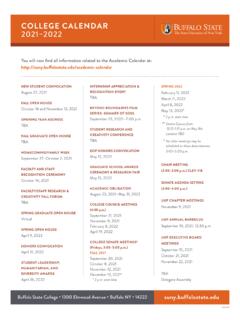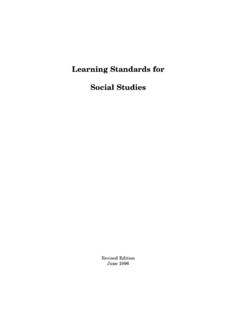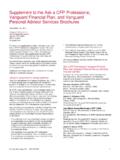Transcription of Relationships Between Minority Students Online Learning …
1 Relationships Between Minority Students Online Learning Experiences and Academic Performance Relationships Between Minority Students Online Learning Experiences and Academic Performance Alex Kumi Yeboah University at albany - suny . Patriann Smith Texas Tech University, Lubbock Texas Abstract The study investigated the relationship Between Minority Students ' use of technology, social media, the number of Online courses, program of study, satisfaction, and academic performance. Participants in the study were a diverse student body regarding age, gender, and educational level, and functioned at both undergraduate and graduate levels. Analysis of variance (ANOVA). and Chi-square tests were used to find the relationship Between participants' Online Learning experiences and academic performance. Results showed that satisfaction and use of social media had no relationship with the academic performance of participants.
2 However, a relationship existed Between the use of technology, the number of courses in Online , program of study, and academic performance. Categories that emerged from the open-ended questions were flexibility and time convenience, self-confidence, lack of support, self-regulated Learning skills, and language and linguistic differences. The authors concluded that varying factors such as cultural, language, personal, and efficacy skills facilitated the academic performance of Minority Students in an Online Learning environment. This study reiterates the importance of establishing multicultural presence in an Online course and suggests best pedagogical methods for teaching Minority Students in an Online course. Keywords: Minority Students , satisfaction, social media, use of technology, academic performance, self-regulated Learning , and self-confidence Online Learning Volume 20 Issue 4 December 2016.
3 Relationships Between Minority Students Online Learning Experiences and Academic Performance Introduction The past two decades reflect a rapid increase in Online Learning in higher education. Online Learning has taken the center stage as one of the best alternative means of instruction as compared to the traditional face-to-face classes. For instance, in 2012, the number of Students who enrolled in at least one Online course increased by over 570,000 to a new total of million. In 2014, the proportion of higher education Students in Online education was at an all- time high of % (Allen & Seaman, 2014). Online education has shifted to a mainstream form of delivery for the majority of higher education institutions. This is primarily due to the growing and aging undergraduate population, rising tuition costs that led to innovative alternatives, an evolving workforce seeking lifelong Learning options, and academic leaders' strategic focus to develop Online Learning strategies (Allen & Seaman, 2014).
4 This phenomenon has made most colleges and universities adopt Online courses as alternative offerings that are scalable, sustainable and personalized to improve academic and employment outcomes for learners (Babson Survey Report, 2014). Several studies (Brown & Liedholm, 2002; Coates, Humphreys, Kane, & Vachris, 2004; Rovai, Ponton, Wighting, & Baker, 2007; Xu & Jaggars, 2011; Xu &. Jaggars, 2013) indicated that Students who choose Online Learning seem to have higher levels of academic ability and motivation in comparison to peers who select a fully face-to-face course. Amidst the increasing growth of Online education is the notion of technology as a major instructional path for university Students who opt to take Online or hybrid courses using available computers and information technologies (Allen & Seaman, 2008). New generations of Students in higher education expect instructors to integrate new technologies, such as Online Learning management systems and collaborative Internet technologies into traditional face-to-face class to enhance their Learning experience.
5 A recent study by EDUCAUSE (Hawkins & Rudy, 2008). reported that the majority of Students at baccalaureate degree-granting institutions own and use their computers. Online Learning management systems (LMS) such as Blackboard, Desire to Learn (D2L), Angel, Canvas, or Sakai are universally applicable to universities, and wireless Internet access permeates most college classrooms (Green, 2007; Hawkins & Rudy, 2008). Several studies indicated that Online courses require Students to assume greater responsibility for their Learning . For example, a successful Online student may need high levels of self-regulation, self-discipline, and metacognitive skills, which often falls under the broad rubric of self-directed Learning (Azevedo, Cromley, & Seibert, 2004; Corbeil, 2003; Guglielmino & Guglielmino, 2002;. Hannafin & Land, 1997; Kearsley, 2002; Williams, 1996; Yen & Liu, 2009). Online Learning provides Students , the ability to self-monitor their understandings, reflects, control interactions about the concepts they learn in an Online setting (Means, Toyama, Murphy, Bakia, & Jones, 2009).
6 As more Students continue to pursue degrees through Online Learning , Students ' pre-existing cultural dispositions associated with their ethnicity or age can largely influence their Learning actions and thoughts, which may be in conflict with the regular Online Learning practices and environments. Further, since the inception of Online or blended Learning courses in college programs, Minority Students have participated in either fully Online course or blended Learning to augment their academic endeavors. Some research studies (Adeoye & Wentling, 2007; Hughes & Bruce, 2006) contend that Online courses ignore cultural and sub- cultural differences in Learning behavior and fail to address the diversity of their learners. However, not much research has been done to investigate the relationship Between Minority Students ' Online Learning experiences and academic performance using a mixed-method Online Learning Volume 20 Issue 4 December 2016.
7 Relationships Between Minority Students Online Learning Experiences and Academic Performance approach. Therefore, the primary focus of this study is to investigate the relationship Between Minority Students ' satisfaction and experiences with Online Learning and their academic performance (As measured by their Grade Point Average). The study's findings on Minority Students ' satisfaction in Online Learning participation and academic performance (As measured by Grade Point Average) will serve to better inform faculty, educational researchers, and policy makers on assessing how Online Learning courses relate to the cultural responsiveness, multicultural expectations, challenges, and achievement of Minority Students . In the following sections, we provide a literature review and a description of the study design and methods, followed by the study results, a discussion of the findings, implications, recommendations, and the conclusion.
8 Literature Review Learning satisfaction in Online Learning is defined as student's perceptions about the course experience and the perceived value of the education received while attending the educational institution (Astin, 1993; Bollinger & Martindale, 2004). Online course refers to a Learning process in which at least 80 % of the course content is delivered Online . The course content is delivered via an Online Learning format (Babson Research Survey/ Online Learning Consortium, 2014). Several researchers (Eom, Wen, & Ashill, 2006; Sun, Tsai, Finger, Chen &. Yeh, 2008) agreed that user satisfaction in Online Learning is a critical measure of Learning outcomes and factor into the success of Online educational system implementation. Online Learning satisfaction is comprised of two dimensions: perceived satisfaction with individual Online courses, and an overall satisfaction with web-based distance education.
9 Researchers in web-based education have suggested the need to create diverse Online Learning interactions for Students , particularly for Minority Students with limited English and social limitations in Online education (Ke & Carr-Chellman, 2006). Online Learning Interaction and Satisfaction According to Thurmond (2003) interaction in Online Learning is the process where: the learner's engagement with the course content, other learners, the instructor, and the technological medium used in the course. True interactions with other learners, the instructor, and the technology results in a reciprocal exchange of information. The exchange of information is intended to enhance knowledge development in the Learning environment. Depending on the nature of the course content, the reciprocal exchange may be absent such as in the case of paper printed content. Ultimately, the goal of interaction is to increase understanding of the course content or mastery of the defined goals (p.)
10 4). Interaction with the instructor is considered to be the most significant contributor to perceived Learning in Online courses (Fredericksen, Pickett, Pelz, Shea, & Swan, 2000). Research has shown that collaborative interactions with peer learners promoted higher levels of satisfaction, social interactions with instructors and better Learning performance, while interactions with academic materials (student-to-content interactions) seemed to play a less significant role (Jung, Choi, Lim, & Leem, 2002). Further research studies have shown that learner instructor interaction is the best predictor of course satisfaction and is by far the most significant predictor of student satisfaction in web-based education (Battalio, 2007; Bolliger &. Online Learning Volume 20 Issue 4 December 2016. Relationships Between Minority Students Online Learning Experiences and Academic Performance Martindale, 2004; Thurmond, 2003; Thurmond & Wambach, 2004).












